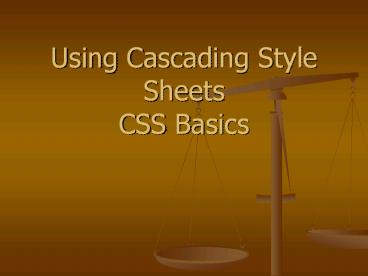Using Cascading Style Sheets CSS Basics - PowerPoint PPT Presentation
1 / 25
Title:
Using Cascading Style Sheets CSS Basics
Description:
Using Cascading Style Sheets CSS Basics – PowerPoint PPT presentation
Number of Views:183
Avg rating:3.0/5.0
Title: Using Cascading Style Sheets CSS Basics
1
Using Cascading Style SheetsCSS Basics
2
Goals
- Understand basic syntax of Cascading Style Sheets
(CSS) - Understand the differences among inline, internal
and external style sheets - Understand how to declare a style
- Understand how to attach specify values
3
Introduction to Styles and Properties
- To ensure that future Web page authoring
separates the definition of the elements in a
document from how they appear, many of the
display and formatting extensions that were added
to the HTML language, such as the ltfontgt element,
were deprecated in HTML 4.0 and in XHTML 1.0 in
favor of CSS
4
Introduction to Styles and Properties
- Cascading Style Sheets (CSS) are a standard set
by the World Wide Web Consortium (W3C) for
managing the design and formatting of Web pages
in a Web browser
5
Introduction to Styles and Properties
- A single piece of CSS formatting information,
such as text alignment or font size, is referred
to as a style - Some of the style capabilities of CSS include the
ability to change fonts, backgrounds, and colors,
and to modify the layout of elements as they
appear in a Web browser
6
Introduction to Styles and Properties
- CSS information can be added directly to
documents or stored in separate documents and
shared among multiple Web pages - The term cascading refers to the Web pages
ability to use CSS information from more than one
source
7
CSS Properties
- CSS styles are created with two parts separated
by a colon the property, which refers to a
specific CSS style, and the value assigned to it,
which determines the styles visual
characteristics - Together, a CSS property and the value assigned
to it are referred to as a declaration or style
declaration
8
CSS Properties
9
Common CSS Properties
10
CSS Properties
- The properties available in CSS1 are grouped into
the following categories - Color and background properties
- Font properties
- Text properties
- Box properties
- Classification properties
11
CSS Properties
- CSS recommendation, Level 2 (CSS2) was released
in 1998 - CSS2 builds on the properties in CSS1 and
includes new features such as table properties
and the ability to change the appearance of the
mouse pointer
12
Inline Styles
- The most basic method of applying styles is to
use inline styles, which allow you to add style
information to a single element in a document
13
Inline Styles
- You use the style attribute to assign inline
style information to an element - You assign to the style attribute a property
declaration enclosed in quotation marks
14
CSS Values
- The values you can assign to a CSS property
depend on what type of property it is - Some properties can be assigned a range of values
15
CSS Values
- For instance, you can assign any font name that
is available on a users system to the
font-family property - For other properties, you must assign a value
from a specific set of values
16
Length Units
- Length units refer to the units of measure that
you can use in a style declaration to determine
the size or positioning of an element - Whether a length unit is used for sizing or
positioning depends on the property and the
element to which it is assigned
17
Length Units
- You assign a measurement value to a property by
assigning the number that represents the
measurement, immediately followed by the unit of
measure
18
CSS Length Units
19
Length Units
- CSS length units are either absolute or relative
- Absolute length units use an exact measurement to
specify the size or placement of an element
20
Length Units
- The following CSS length units are absolute
- cm (centimeters)
- in (inches)
- mm (millimeters)
- pc (picas)
- pt (points)
21
Length Units
- Relative length units are preferred because they
adjust properties according to screen size or
user preferences - The following CSS length units are relative
- em (em space)
- ex (x-height)
- px (pixels)
22
Percentage Units
- An alternative to relative length units is
percentage units, which adjust properties
relative to other values - You assign a percentage unit value to a property
by assigning a number that represents the
percentage, immediately followed by the percent
symbol ()
23
Color Units
- A color unit represents a color value that you
can assign to a property - You can assign a color unit to a property using
any one of 16 color names defined in the CSS1
specification
24
Color Units
25
Color Units
- Most graphical computer systems use the RGB color
system for specifying colors - You can also assign a color using the RGB color
system - Refer to appendix/resource for information on
assigning colors with the RGB color system































